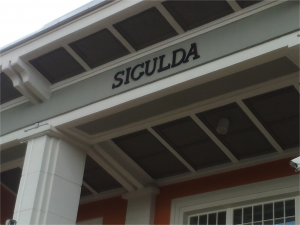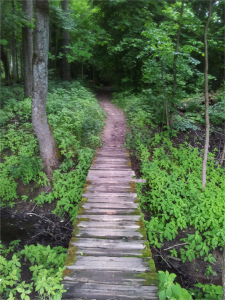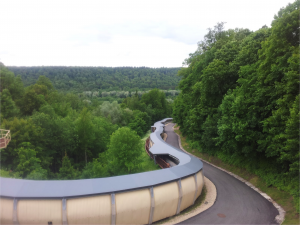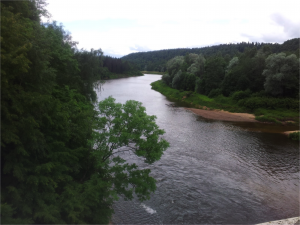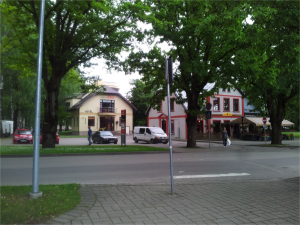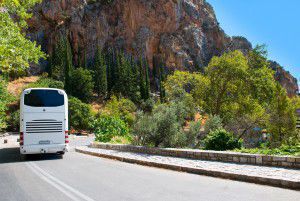A couple of days in Berlin
After volunteering in a hostel in Riga for six weeks, I decided to take the long way home via a series of overnight buses. With everyone raving about how beautiful a city Berlin is, I decided to make it my next stop on my journey home.
It is easy to see why people like it so much.
I stayed in a huge hostel in the Turmstrasse area and this seemed like a really good location to stop in. Just twenty minutes away was the Victory Column, or Siegessäule, which overlooks a large portion of the city. A little further was Potsdamer Platz; the centre is all commercial with cafes and restaurants as far as the eye can see and business reaching high up into the sky from a series of highly polished skyscrapers. But the surrounding area has a lot of history and culture to offer too. Personally the Topography Of Terror, Holocaust Memorial, Friedrichstrasse and Reichstag were the things that grabbed my attention the most. An early evening stroll in the local neighbourhood turned into a several hour stint that saw me leave my hostel, walk the length of Turmstrasse, past the Victory Column, down to the Holocaust Memorial and back on my first night.
There is no one ‘centre’ to Berlin, but it seems most tourists and locals end up at Alexanderplatz. Walking out of the station the first thing you see is the iconic tower that overlooks a pedestrianised area. Walking behind this and into a little blissful shade after a journey on an overheated train was very refreshing. There is a lot to see from here, and I personally headed over towards the galleries and sat under the pillars looking out over the river for a while.
The Zoological Gardens are definitely worth a visit, and if you like zoos and aquariums then it is a must. There’s a very cute windmill of sorts that sits along a section of Budapester Strasse which is worth stopping at to admire.
The Brandenburg Gate was such an impressive sight first hand, you can really understand the sense of power there and the thought of those streets being lined with people waiting to see a glimpse of their leader is both disturbing and breathtaking.
The area around Nordbahnhof was one of my favourite places, full of gardens, interesting architecture, and of course the Berlin Wall Memorial.
The main station, Hauptbahnhof, was also worth looking round, whether you like trains or not. There are so many levels, platforms, different types of train, shops, places to eat and drink, you could spend hours within this huge complex and not get bored.
Of course, one of the best things about Berlin, from my perspective at least, is the cake. Much like Greggs back home in the UK, there is a bäckerei (bakery) wherever you turn, and such a choice of sweet and savoury treats it can be a little overwhelming.
I spent the best part of two days in Berlin and I have to say, it isn’t enough. I could have happily stayed another week and I am still not sure if that would have been enough to have seen everything that I wanted to. A return trip is definitely in order!
Kelly
Planning a trip to Berlin? Remember to learn a little German before you leave with uTalk – or try our free Talk Now demo.
10 reasons to visit… Sigulda
If you haven’t heard of Sigulda, you probably aren’t in the minority. Described as the ‘Switzerland of Vidzeme’, Sigulda is popular with both locals and tourists alike. It is well worth a Google to see if it’s your thing.
Sigulda is a small town about 50 kilometres from Riga, Latvia. To get there from Riga takes about 45 minutes by car or around an hour by either train or bus. Sigulda sits on the edge of the Gaujas National Park, so there’s the opportunity to do both urban and natural sightseeing. The bus is 2,15 euros and the train 2,35; both are good, regular services.
The journey from Riga is very scenic, and if there’s any doubt that Latvia is the land of trees, this will quickly be removed the further you get into the countryside. Miles and miles of coppiced trees as well as trees left to succession, mostly birches in the deeper parts of the forest and silver birches lining the roads. In some places there are clumps of a species of bluebell and if it weren’t for the girth of the trees giving away their youth, you could be forgiven for mistaking some of the park as ancient woodland from England.
If you have two days to spare then you can see and do pretty much everything that Sigulda has to offer, but if you only have one day then that is ample time to have a good look around.
Sigulda is cute. It’s quaint. Cute little buildings, quaint little streets, homes that look like they are out of someone’s summer house dreams. Daisies are scattered throughout every area of grass, and there are wildflowers everywhere you look. A beautiful river, dramatic views where likely glacial erosion has shaped the landscape into an undulating wonder of a painter’s paradise. Which, coincidentally, is the name of one of the places suggested to visit.
Here’s a quick rundown of the ten best things to visit in Sigulda…
1. Bob Sleighing
You can follow the luge track from the Winter Olympic Games of 2014, and even if you’d rather just have a look at the site rather than take part, it’s an impressive view.
2. Sigulda Adventure Park Tarzan
If you’ve ever been to Go Ape, it’s pretty much the same deal. In other words, a lot of fun, in scenic surroundings.
3. Old Sigulda Castle
There are so many to choose from and if you’re pushed for time this one is (in my opinion) the prettiest. The original castle was built back in 1207 and the walls have been fortified multiple times owing to the tourist interest in the site.
4. Gutmanis Cave
If you like your caves this is a good alternative to Wookey Hole [in Somerset, England]! This is apparently both the largest and highest cave system in Latvia. It is thought to have begun forming 10,000 years ago at the end of the Ice Age.
5. Gauju River
You have two options here. You can either climb down a very lengthy but beautiful set of wooden stairs and walk over the bridge yourself (prepare yourself for the climb back. You will mostly likely have to stop a few times unless you have super-strength lungs or an incredible level of fitness). Or, if that sounds far too active for you, you can take the cable car that flies right over the top and gives you incredible views of the valley below. And as if that isn’t exciting enough, you can also bungee jump from the cable car. Obviously, this is optional.
6. Painters’ (Paradise) Hill
Stand on the top of this and you can look down on a valley at an almost never-ending tree line that is cut by the meandering Gauju River.
7. Town centre architecture
The town centre really is the most adorable little place to wander around aimlessly, lots of cute buildings with interesting facades. If you don’t feel like a ‘nature’ day you can happily amuse yourself here.
8. Aerodium
This is a giant wind tunnel that you can pretend you are sky-diving on, and is a lot of fun.
9. Sigulda Evangelic Lutheran Church
What list of things to visit would be complete without the obligatory church? This one is actually very pretty and definitely worth a look.
10. Mr. Biskvīts
Last but not least, there must be somewhere to eat and drink. This place is conveniently placed next to the train/bus station/central square and has an excellent range of hot and cold drinks as well as some very delicious food. Simply a must.
If you visit Riga, and this is highly recommended, a day trip to Sigulda during your stay is definitely worth your time. The tourism office is right next to the waiting room for the train/bus station and the staff will fall over themselves to help you. And if you want to plan ahead, check out the Sigulda Tourism site.
Kelly
Top 10 tips for learning a language
We originally published this infographic back at the start of last year as ‘top 10 tips for learning a language in 2014‘. But if there’s one thing we know, it’s that learning a language is something you can do anytime, anywhere.
So here are our top 10 tips for learning a language – whenever you want!
If anyone has any more top tips that work really well for you, please share them in the comments. Thank you 🙂
Way, Haul Away… Sea shanties and language learning
Last weekend, I spent a very merry, slightly tipsy few days at the International Sea Shanty Festival in Falmouth.
International What, now? Allow me to explain.
 Every year, Falmouth town hosts a three-day festival of nautical songs and chants, to which people flock not only from all over Cornwall, but from foreign parts too – Ireland, Brittany, England, even America. Every B&B, campsite and hotel is full to the brim with shantymen (and, increasingly, some shantywomen!), and the streets swarm with be-smocked musicians and the occasional pirate. Nearly every pub (of which Falmouth has a very generous range) becomes a venue for the various shanty bands, who also play on street corners, outside shops and in the public squares.
Every year, Falmouth town hosts a three-day festival of nautical songs and chants, to which people flock not only from all over Cornwall, but from foreign parts too – Ireland, Brittany, England, even America. Every B&B, campsite and hotel is full to the brim with shantymen (and, increasingly, some shantywomen!), and the streets swarm with be-smocked musicians and the occasional pirate. Nearly every pub (of which Falmouth has a very generous range) becomes a venue for the various shanty bands, who also play on street corners, outside shops and in the public squares.
Each hour, a venue’s lineup changes, and you’ll see canvas smocks in Breton red, navy blue and stripes scurrying from one establishment to another as they get ready to set up for their next gig. Every year, I make elaborate plans to switch venue every hour to see all the bands I want to see, but inevitably the beer in one pub ends up being unusually good, and a seat becomes vacant, and 7 hours later you find that somehow you’re still in the same venue and 7 different bands have floated on and off stage before your eyes, whilst old-timers have come and shared your table and had a natter about… well, everything under the sun. Which is all very much in the spirit of the festival.
So what is a shanty?
Most people think the name ‘shanty’ comes from the French ‘chanter’ (to sing). Although there’s some debate about this, what’s definite is that a shanty is a traditional form of song sung by sailors, which aims to reflect the rhythm of the work on deck (hauling halyards, pulling the anchor, setting jibs, winding a capstain). Often, a lead shantyman will give the ‘call’ and then the other crew will give the ‘response’ (short, sharp calls and responses for the jobs requiring bursts of energy; longer, more lyrical ones for the slower jobs). Working shanties often feature the nature of the work itself as the main theme – ‘Haul Away Joe’, ‘Wey, hey, blow the man down!’ – but for those lonely evenings or periods of comparative calm, there are the wistful shanties which recall the shore and all its comforts – ‘Spanish Ladies’, ‘Maggie May’ – and remind the young sailors of their sweethearts left behind (often including a not-so-veiled warning about what said sweethearts are most likely getting up to with other boys whilst their sailors are at sea).
Who sings shanties nowadays?
There are plenty of shanty bands around the country – and the world. This weekend alone, I saw bands from Falmouth, Treverva, Salisbury (not a lot of sea in Salisbury, but there you go), Brittany, Exmouth, Holland, Poland, Yorkshire, and plenty more places. Some are professional groups with regular gigs of their own, whilst others are more casual affairs – people who just love to shant!
What’s all this got to do with language?
I’m glad you asked. The thing is that although shanties get sung in all sorts of languages and dialects, you never, ever feel left out by not understanding the words. Turn up to one of the Breton bands and (unless you speak Breton or Cornish), you probably won’t have a clue what the words mean, but you’ll definitely understand the spirit of it, and before long you’ll find yourself singing along to the chorus, arm in arm with everyone else. In part, this is because shanties are very repetitive by nature, so it’s easy to pick up on lyrics and sing along.
All of which makes me think that singing has got to be a great way to pick up a new language – and any type of song will do! Nursery rhymes, pop songs, national anthems, folk songs, poems, choral music, raps; it all helps, it really does. I still remember all the Zulu words to ‘Siyahamba’, which Safia and I learned over just a few days (video evidence below). And even if you don’t know exactly what all the words mean to begin with, it’s a huge encouragement to be able to fluently reel off a couple of sentences in your new language, all learned through song.
…Way, Haul Away,
We’ll Haul Away, Joe!
Nat
The Long And Winding Road… of Long Distance Bus Travel
If you’re on a budget or just want to indulge in a bit of thinking time, travelling across Europe by bus could be the thing for you. With numerous companies offering fantastic prices, it’s a wonder that more people haven’t partaken in this not-so-secret method of transport.
Based on two particular routes*, here are some ‘dos and don’ts’ from our own personal experience.
Checking In
If you are travelling from the UK, Victoria Coach Station insist on you being available to check in at least one hour before departure. From other countries it is usually around half an hour maximum.
Check in normally involves only showing your ticket or reference number, however in some places there will also be an additional check of your ID card or passport.
If you want to guarantee a window seat or that your luggage is on first, face the fact that you will have to queue. Embrace it. Or at least prepare some good music to dance to whilst waiting.
Luggage
Whilst coach companies are very generous and often overlook oversized luggage, don’t get too greedy. Luggage limits are usually around 25kg and it’s mostly okay to go over that – although not with your entire house. On a very recent trip one single traveller was furious that her guitar, record player, large holdall, large backpack, and two very large suitcases were deemed too much. Shocking.
On The Bus
Thankfully coach seats do not recline as much as plane seats might, but there will always be someone who believes they alone need all the body space and legroom that is/isn’t available.
Mind where you sit. If you’re someone who needs the toilet regularly then you have to weigh up the pros of being close to the toilet with the cons of constantly hearing the door slam and the toilet flush – amongst other things.
Also. Take tissue with you. The one solitary toilet roll that is often installed in coach toilets pretty quickly disappears, so if you need to use the facilities more than two hours into the journey, take your own supply.
Trips to the toilet in the middle of the night can either be a human assault course or a foot fetishist’s idea of heaven: those lucky enough to not have to share a seat will sprawl out as best they can, with feet both socked and bare blocking your way. Do what you will.
Take headphones or earplugs. You are guaranteed to have either one token unhappy child or one potentially unstable adult who feels the need to tell everyone their life story. Look busy. At all times.
A small blanket is a very good idea for the coach, no matter the season you travel in. There’s nothing worse than attempting to sleep as a contortionist might, when there’s a breeze coming in on your back or you are shivering.
If you board a bus that originates from the UK, and you happen to have a UK adapter/plug, guard it with your life. For once other unprepared passengers are aware of this little treasure, everyone will suddenly want to befriend you and ‘borrow’ it.
Regular Stops
When there is a stop, use the toilet. Whether you feel the urge or not. If nothing else it is an opportunity to wash your hands thoroughly as the sinks in coach toilets always seem to have the smallest trickle of water and very little soap.
Take plenty of change with you for the vending machines at service stations. Not only will this work out cheaper than buying a ‘proper’ coffee at every stop, you will also be pleasantly surprised by the range and quality of hot beverages available. Especially in France. May we recommend the vanilla cappuccino.
Crossing The Channel
Depending on the time of day, you will either face the claustrophobic challenge that is the Channel Tunnel, or walk around a ferry at your leisure for around an hour before trying to find your coach again at the last minute. The ferry feels much more civilised as you can lounge on sofas or pace up and down the deck, but the Tunnel is much faster.
Be prepared for long delays at the border. It can either take under half an hour to go through the two separate controls for France and England, or it can take two hours. It depends on if they feel like checking your luggage as well as your passports, if they want their sniffer dogs to check you over, and if your fellow passengers who need visas have filled in or need help with filling in their paperwork.
Pet Peeves And Pluses
The main pet peeve of long distance coach travel, it has to be said, are Those People. You know the ones. Those who feel that every single stop, be it to refuel or for the driver to change, is their own personal cigarette break. Those that when the driver says there is a 45 minute break, decide to casually stroll into the service station five minutes before departure and delay the coach with their hot drinks that the driver has clearly said are not allowed onboard. Those that are veterans of the journey and will not leave the driver alone for a moment, or will give the entire coach a loud, running commentary the entire route.
A big plus is the long stops when changing buses. Stopping in Paris for 3 hours gives you ample time to wander to the Eiffel Tower and Arc de Triomphe as well as popping into a patisserie for a cheeky pastry for your petit dejeuner.
It does have to be said though, at least in our experience, that the drivers make the journey. They are jolly, they tell bad jokes, and they cheer you on with gusto to encourage you to get through the border control quicker than their previous coach passengers. Definitely an added bonus that will make you smile.
Bus travel. It isn’t for everyone. But perhaps it is for you.
Kelly
One more plus from us: you’ll meet loads of interesting people on your bus journey. Why not download uTalk for iOS, so you’ll always know how to say hello, even if you’re from different countries?
*Budapest to London, via Eurolines, with a travel time of 26 hours and 45 minutes. Calling at: Győr, Vienna, Linz, Liege, Brussels, Ghent, Lille and Dover before terminating at Victoria Coach Station, London.
Barcelona to London, via Megabus, travelling for approximately 26 hours. Calling at: Toulouse, Brive, Paris and Amiens and terminating at Victoria Coach Station.



